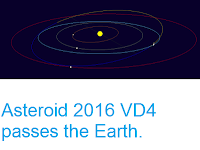Asteroid (369264) 2009 MS passed the Earth at a distance of 10 410 000
km (about 27.1 times the distance between the Earth and the
Moon or 6.96% of the distance between the Earth and the Sun), slightly
before 8.30 pm GMT on Wednesday 30 November 2016. There was
no danger of the asteroid hitting us, though if were to do so it would
present a significant threat. (369264) 2009 MS is estimated to be
between 1000 and 3300 m in diameter, and an asteroid of this size would be
expected to pass directly through the atmosphere, striking the Earth's
surface and creating a crater over 13 km in diameter, as well as causing
devastation over a wide area and global climatic effects that would
potentially last for centuries.
The calculated orbit of (369264) 2009 MS. Minor Planet Center.
(369264) 2009 MS was discovered on 19 June 2009 by the
University of Arizona's Mt. Lemmon Survey at the Steward Observatory on Mount
Lemmon in the Catalina Mountains north of Tucson. The designation 2009 MS
implies that the asteroid was the 18th object (object S) discovered in the second half of June 2016 (period 2009 M),
while 369264 indicates that it was the 369 264th asteroid discovered
overall (asteroids are not given this longer designation immediately, to
ensure that numbered objects are genuine asteroids that have not been
previously described).
(369264) 2009 MS is calculated to have a 1037 day orbital
period and an elliptical orbit tilted at an angle of 52.4° to the plain of the
Solar System that takes it from 0.86 AU from the Sun (i.e. 86% of the average
distance at which the Earth orbits the Sun) to 3.14 AU from the Sun (i.e. 314%
of the average distance at which the Earth orbits the Sun, more than twice the
distance at which the planet Mars orbits the Sun). It is therefore classed as
an Apollo Group Asteroid (an asteroid that is on average further from the Sun
than the Earth, but which does get closer). This means that close encounters between the
asteroid and Earth are extremely common, with the last having occurred
in November 1999 and the next predicted in December 2033. As
an asteroid possibly larger than 150 m in diameter that occasionally
comes within 0.05 AU of the Earth, (369264) 2009 MS is also classified
as a Potentially Hazardous Asteroid.
See also...
Follow Sciency Thoughts on Facebook.







